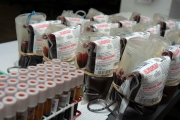Posted on July 13, 2013
Source: The New Yorker

Ryan White was fourteen years old in 1985 when the parents of his classmates at a public school in Kokomo, Indiana, made it clear that he was no longer welcome. A hemophiliac, White had contracted H.I.V. during a blood transfusion, and was diagnosed with AIDS in December, 1984. The human immunodeficiency virus and the acquired-immunodeficiency syndrome it causes were poorly understood at the time and, despite the advice of doctors, families feared that casual contact would infect their children.
The Times’ obituary for White, published when he was eighteen years old—a month shy of his high-school graduation—recorded the daily hell he and his family were put through: schoolyard jeers and obscene taunts, broken windows, slashed tires. “When his mother, Jeanne White, went to the grocery store,” it said, “cashiers would throw down her change to avoid touching her hands.” For the media, White was a poster child: a corn-fed cautionary tale of what a gay golem had wrought, an innocent victim of some sodomite plague. But the boy, however sick, threw that mantle off with vigor, reminding Americans that every other person the disease struck down had been just as innocent as he. In the early years of the epidemic, many of those were hemophiliacs like White; thousands contracted H.I.V. through blood products used to combat their bleeding disorder. H.I.V. testing was in its infancy, and the F.D.A., which regulates blood banks, was slow to adjust to the introduction of the infection into the national bloodstream, and to the devastation the virus wrought. In “And the Band Played On,” his history of AIDS, Randy Shilts documents a meeting in January, 1983, not two years before White’s diagnosis, in which Don Francis, a researcher at the Centers for Disease Control, began shouting at representatives of the blood-bank industry and F.D.A. officials: “How many people have to die? How many deaths do you need? Give us the threshold of death that you need in order to believe that this is happening, and we’ll meet at that time and we can start doing something.” That year, before the virus was even named, the F.D.A. finally took a first step toward preventing members of populations at high risk for H.I.V.—especially, but not limited to, gay men—from donating blood. It would be another two years before they made the policy more stringent.
The slow response from the F.D.A. marked a general apprehension and discomfort toward the disease—and the population among which it was spreading. This was an era that afforded gays little respect. In 1986, as Alex Ross recalled in an article for the magazine last fall, the Supreme Court “dismissed the notion of constitutional protection for gay sexuality as ‘at best, facetious.’ ”
It is a warmer moment now for gays. The Court declared sodomy laws unconstitutional in 2003, and struck down key parts of the Defense of Marriage Act last month. Yet to the F.D.A., the blood of a sexually active gay man remains, by definition, unclean. A man who has sex with a woman he knows to be H.I.V. positive, and who then tests negative for the virus, is permitted to give blood a year after intercourse. But for any man who has had sex, even once, with another man (an M.S.M., in the medical designation) at any time since 1977, the scourge of lifestyle, the assumption, is enough.